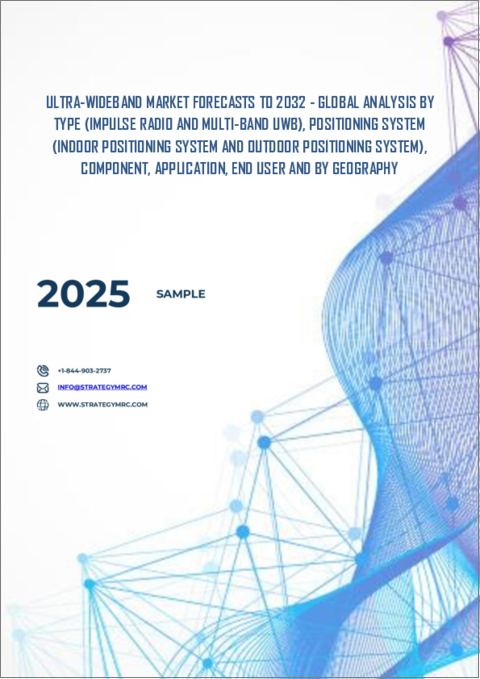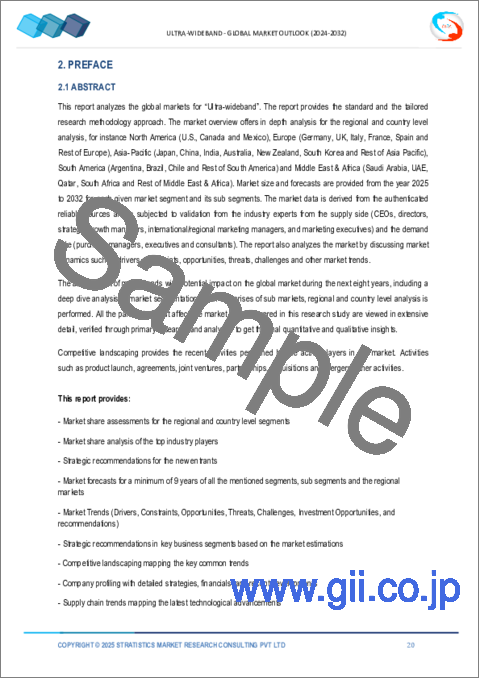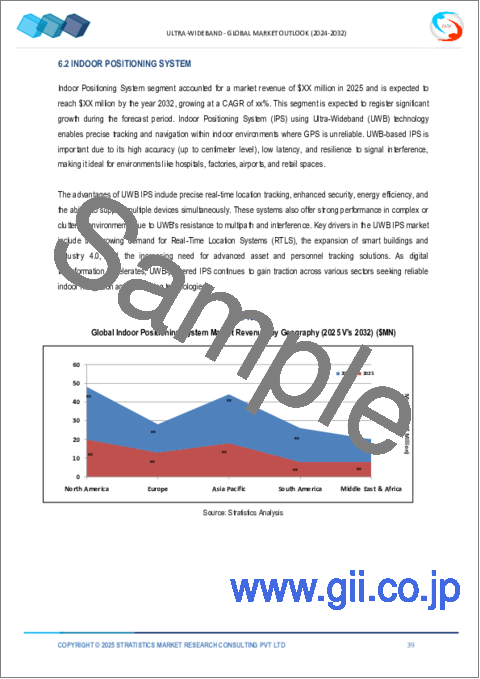|
|
市場調査レポート
商品コード
1577155
超広帯域(UWB)市場の2030年までの予測:タイプ別、測位システム別、コンポーネント別、用途別、エンドユーザー別、地域別の世界分析Ultra-wideband Market Forecasts to 2030 - Global Analysis By Type (Impulse Radio and Multi-band UWB), Positioning System (Indoor Positioning System and Outdoor Positioning System), Component, Application, End User and by Geography |
||||||
カスタマイズ可能
|
|||||||
| 超広帯域(UWB)市場の2030年までの予測:タイプ別、測位システム別、コンポーネント別、用途別、エンドユーザー別、地域別の世界分析 |
|
出版日: 2024年10月10日
発行: Stratistics Market Research Consulting
ページ情報: 英文 200+ Pages
納期: 2~3営業日
|
- 全表示
- 概要
- 図表
- 目次
Stratistics MRCによると、超広帯域(UWB)の世界市場は2024年に24億1,000万米ドルを占め、予測期間中のCAGRは21.6%で成長し、2030年には77億8,000万米ドルに達する見込みです。
超広帯域(UWB)(UWB)は、高いデータ転送速度と正確な空間・方向精度を提供する無線技術です。幅広い周波数帯域で動作します。UWBは、従来のナローバンド・システムとは対照的に、通常500MHz以上の広い周波数帯域でデータを送信するため、干渉が少なく、迅速な通信が可能です。UWBは短距離のアプリケーションで非常にうまく機能するため、屋内ナビゲーション、安全なアクセス制御、位置情報サービスに最適です。UWBは、ウェアラブル端末、スマートフォン、リアルタイム測位やキーレス・エントリーなどの機能を備えた自動車システムなどで、より頻繁に利用されるようになっています。
米連邦通信委員会(FCC)によると、超広帯域(UWB)は2002年に商業利用が正式に認可され、通信、レーダー、測位システムへの応用が可能になった。
高速データ・トランスミッションの需要
UWB市場を推進する大きな要因の1つは、高速データ伝送の必要性です。VR(仮想現実)、AR(拡張現実)、高解像度ビデオストリーミングなどのアプリケーションが一般的になるにつれ、低遅延で大容量データパケットを処理できる技術が重要になっています。UWBは、短距離で100Mbpsを超える速度でデータを送信できるため、こうしたアプリケーションに特に適しています。さらに、スマートフォンやウェアラブル端末、その他のスマートデバイスのメーカーは、消費者がより途切れのないシームレスな体験を求める中、接続性を向上させる実用的なソリューションとしてUWBに注目しています。
既存技術との競合
競合環境は、UWBの採用にとってもう一つの障害となります。ユーザー基盤が確立しているBluetoothやWi-Fiのような技術は、スピードと効率を求める消費者のニーズを満たすために常に変化しています。UWBは市場への登場が遅く、既存技術の牙城であるため、精密な位置追跡やデータ・トランスミッション機能で優位性があるにもかかわらず、家電製品で大きな市場シェアを獲得するのは困難だった。さらに、UWBは主流ではなくニッチなソリューションであるとの見方が、メーカーや消費者に受け入れられにくくしています。
スマートホームとIoTの統合
スマートホームシステムと、より大規模なモノのインターネット(IoT)エコシステムの発展は、UWB技術によって大いに助けられると期待されています。その正確な測距能力により、住宅は資産追跡、スマート照明制御、部屋レベルまでの居住者検知などの位置情報サービスの恩恵を受けることができます。さらに、UWBはスムーズなデバイス接続を可能にし、スマート環境でのユーザー体験を向上させる。消費者によるスマートホーム技術の採用が進むにつれ、これらのシステムにUWBを組み込むことで機能性とパーソナライゼーションが向上すると思われます。
セキュリティとプライバシーの問題
UWB技術は、位置情報の追跡を驚くほど正確に行うため、プライバシーとセキュリティに深刻な問題を引き起こします。適切に規制されなければ、極めて正確に人や資産を追跡する能力が悪用されたり、不正な監視につながったりする可能性があります。消費者が自分のプライバシーにリスクがあると考えたり、自分の行動が許可なく追跡される可能性があると考えたりすれば、UWB対応機器の導入に消極的になるかもしれないです。
COVID-19の影響:
超広帯域(UWB)市場は、COVID-19の大流行によって大きな影響を受けた。製造業の操業停止や操業制限により、パンデミックは当初サプライチェーンを混乱させ、家電、ヘルスケア、自動車などの業界に影響を与えました。その結果、UWBコンポーネントの生産と流通に遅れが生じ、コストも上昇しました。しかし、パンデミックはUWB技術に新たな展望ももたらし、特に社会的距離の調整や連絡先の追跡に関連するアプリケーションに大きな影響を与えました。UWBは追跡精度が高いため、公共機関や職場の環境において交流を監視し、安全規制を実施したい組織にとって有用なツールです。
予測期間中、インパルス無線セグメントが最大になる見込み
多くのアプリケーション、特にリアルタイム・ロケーション・システム(RTLS)や通信技術で幅広く使用されているため、超広帯域(UWB)市場ではインパルス無線セグメントが最大の市場シェアを占めています。高いデータ・レートと正確な距離測定を実現するために、インパルス無線は広い周波数帯域で短時間のパルスを送信します。ヘルスケア、自動車、家電など、正確な位置情報と信頼性の高いデータ転送が不可欠な業界では、この機能は非常に有益です。さらに、インパルス無線は、安全なアクセス制御や非接触決済などの用途でUWB技術の必要性が高まっているため、ますます普及しています。
予測期間中、CAGRが最も高くなると予想されるセンサー分野
超広帯域(UWB)市場で最もCAGRが高いと予測されるのはセンサー分野です。ヘルスケア、自動車、スマートホーム技術など、複数の産業で正確で信頼性の高い位置追跡の需要が高まっていることが、この拡大の理由です。さらに、産業界がIoTソリューションとスマートインフラ構想を採用し続ける中、UWBセンサーの統合は業務効率とユーザーエクスペリエンスを大幅に改善すると予想されます。また、非接触決済やセキュアアクセスシステムの普及に伴い、UWBの能力を活用した高度なセンサー技術も求められています。
最もシェアの高い地域:
超広帯域(UWB)技術市場は北米が支配的です。米国を中心とした最先端技術企業や研究機関の存在感が強いことが、この優位性の要因のひとつです。この地域は、高度に発達した技術インフラと、家電、ヘルスケア、自動車などさまざまな産業におけるUWBアプリケーションへの多額の投資という利点を享受しています。さらに北米では、データ・トランスミッションや正確な位置追跡のニーズが高まっていることに加え、規制面でのサポートもUWBの普及を後押ししています。
CAGRが最も高い地域:
技術の急速な進歩とスマートシティプロジェクトへの投資の増加により、超広帯域(UWB)市場はアジア太平洋地域で最も高いCAGRで成長すると予想されます。UWB技術は、中国、日本、韓国などの国々で、家電、自動車、産業オートメーションなどさまざまな産業に広く採用されています。これらの国々では中間所得層が拡大しており、接続性の向上や正確な位置追跡など、UWB機能を備えた最先端の電子機器への需要が高まっています。さらに、この地域は、スマートホーム技術や自動車のキーレス・エントリー・システムなどのアプリケーションにUWBを組み込むことに注力しているため、主要成長市場として位置づけられています。
無料カスタマイズサービス:
本レポートをご購読のお客様には、以下の無料カスタマイズオプションのいずれかをご利用いただけます:
- 企業プロファイル
- 追加市場プレイヤーの包括的プロファイリング(3社まで)
- 主要企業のSWOT分析(3社まで)
- 地域セグメンテーション
- 顧客の関心に応じた主要国の市場推計・予測・CAGR(注:フィージビリティチェックによる)
- 競合ベンチマーキング
- 製品ポートフォリオ、地理的プレゼンス、戦略的提携に基づく主要企業のベンチマーキング
目次
第1章 エグゼクティブサマリー
第2章 序文
- 概要
- ステークホルダー
- 調査範囲
- 調査手法
- データマイニング
- データ分析
- データ検証
- 調査アプローチ
- 調査情報源
- 1次調査情報源
- 2次調査情報源
- 前提条件
第3章 市場動向分析
- 促進要因
- 抑制要因
- 機会
- 脅威
- 用途分析
- エンドユーザー分析
- 新興市場
- COVID-19の影響
第4章 ポーターのファイブフォース分析
- 供給企業の交渉力
- 買い手の交渉力
- 代替品の脅威
- 新規参入業者の脅威
- 競争企業間の敵対関係
第5章 世界の超広帯域(UWB)市場:タイプ別
- インパルスラジオ
- マルチバンドUWB
第6章 世界の超広帯域(UWB)市場:測位システム別
- 屋内測位システム
- 屋外測位システム
第7章 世界の超広帯域(UWB)市場:コンポーネント別
- センサー
- 集積回路
- マザーボード
第8章 世界の超広帯域(UWB)市場:用途別
- リアルタイム位置情報システム(RTLS)/WNS
- イメージング
- コミュニケーション
- レンジング
- ワイヤレスUSB
- 認証
- その他の用途
第9章 世界の超広帯域(UWB)市場:エンドユーザー別
- 住宅
- 自動車・輸送
- 製造業
- ITおよび通信
- ヘルスケア
- 家電
- 小売り
- その他のエンドユーザー
第10章 世界の超広帯域(UWB)市場:地域別
- 北米
- 米国
- カナダ
- メキシコ
- 欧州
- ドイツ
- 英国
- イタリア
- フランス
- スペイン
- その他欧州
- アジア太平洋
- 日本
- 中国
- インド
- オーストラリア
- ニュージーランド
- 韓国
- その他アジア太平洋地域
- 南米
- アルゼンチン
- ブラジル
- チリ
- その他南米
- 中東・アフリカ
- サウジアラビア
- アラブ首長国連邦
- カタール
- 南アフリカ
- その他中東とアフリカ
第11章 主な発展
- 契約、パートナーシップ、コラボレーション、合弁事業
- 買収と合併
- 新製品発売
- 事業拡大
- その他の主要戦略
第12章 企業プロファイリング
- Emerson Electric Co.
- Infineon Technologies
- STMicroelectronics
- Humatics Corporation
- Intel Corporation
- NXP Semiconductors
- 3M Company
- Honeywell International Inc.
- Qorvo, Inc.
- Samsung Electronics Co., Ltd.
- Texas Instruments Incorporated
- Alereon Inc.
- Qualcomm Incorporated
- Zebra Technologies Corporation
- Robert Bosch GmbH
List of Tables
- Table 1 Global Ultra-wideband Market Outlook, By Region (2022-2030) ($MN)
- Table 2 Global Ultra-wideband Market Outlook, By Type (2022-2030) ($MN)
- Table 3 Global Ultra-wideband Market Outlook, By Impulse Radio (2022-2030) ($MN)
- Table 4 Global Ultra-wideband Market Outlook, By Multi-band UWB (2022-2030) ($MN)
- Table 5 Global Ultra-wideband Market Outlook, By Positioning System (2022-2030) ($MN)
- Table 6 Global Ultra-wideband Market Outlook, By Indoor Positioning System (2022-2030) ($MN)
- Table 7 Global Ultra-wideband Market Outlook, By Outdoor Positioning System (2022-2030) ($MN)
- Table 8 Global Ultra-wideband Market Outlook, By Component (2022-2030) ($MN)
- Table 9 Global Ultra-wideband Market Outlook, By Sensors (2022-2030) ($MN)
- Table 10 Global Ultra-wideband Market Outlook, By Integrated Circuits (2022-2030) ($MN)
- Table 11 Global Ultra-wideband Market Outlook, By Motherboard (2022-2030) ($MN)
- Table 12 Global Ultra-wideband Market Outlook, By Application (2022-2030) ($MN)
- Table 13 Global Ultra-wideband Market Outlook, By Real-Time Location System (RTLS)/WNS (2022-2030) ($MN)
- Table 14 Global Ultra-wideband Market Outlook, By Imaging (2022-2030) ($MN)
- Table 15 Global Ultra-wideband Market Outlook, By Communication (2022-2030) ($MN)
- Table 16 Global Ultra-wideband Market Outlook, By Ranging (2022-2030) ($MN)
- Table 17 Global Ultra-wideband Market Outlook, By Wireless USB (2022-2030) ($MN)
- Table 18 Global Ultra-wideband Market Outlook, By Authentication (2022-2030) ($MN)
- Table 19 Global Ultra-wideband Market Outlook, By Other Applications (2022-2030) ($MN)
- Table 20 Global Ultra-wideband Market Outlook, By End User (2022-2030) ($MN)
- Table 21 Global Ultra-wideband Market Outlook, By Residential (2022-2030) ($MN)
- Table 22 Global Ultra-wideband Market Outlook, By Automotive & Transportation (2022-2030) ($MN)
- Table 23 Global Ultra-wideband Market Outlook, By Manufacturing (2022-2030) ($MN)
- Table 24 Global Ultra-wideband Market Outlook, By IT and Telecom (2022-2030) ($MN)
- Table 25 Global Ultra-wideband Market Outlook, By Healthcare (2022-2030) ($MN)
- Table 26 Global Ultra-wideband Market Outlook, By Consumer electronics (2022-2030) ($MN)
- Table 27 Global Ultra-wideband Market Outlook, By Retail (2022-2030) ($MN)
- Table 28 Global Ultra-wideband Market Outlook, By Other End Users (2022-2030) ($MN)
Note: Tables for North America, Europe, APAC, South America, and Middle East & Africa Regions are also represented in the same manner as above.
According to Stratistics MRC, the Global Ultra-wideband Market is accounted for $2.41 billion in 2024 and is expected to reach $7.78 billion by 2030 growing at a CAGR of 21.6% during the forecast period. Ultra-wideband (UWB) is a wireless technology that offers high data transfer rates and precise spatial and directional accuracy. It operates over a broad range of frequency bands. UWB, in contrast to conventional narrowband systems, transmits data over a wide spectrum-typically more than 500 MHz-allowing for quick communication with little interference. Because UWB works so well in short-range applications, it is perfect for indoor navigation, secure access control, and location-based services. It is being utilized more frequently in wearables, smartphones, and car systems for features like real-time positioning and keyless entry.
According to the Federal Communications Commission (FCC), Ultra-wideband (UWB) was officially approved for commercial use in 2002, allowing its application in communications, radar, and positioning systems, which has since spurred innovation in precise location-based technologies.
Market Dynamics:
Driver:
Demand for high-speed data transmission
One major factor propelling the UWB market is the need for high-speed data transmission. Technologies that can handle large data packets with low latency are critical as applications like virtual reality (VR), augmented reality (AR), and high-definition video streaming become more common. UWB is especially well-suited for these applications because of its capacity to send data at speeds greater than 100 Mbps over short distances. Additionally, manufacturers of smartphones, wearables, and other smart devices are looking to UWB as a workable solution to improve connectivity as consumers demand more uninterrupted and seamless experiences.
Restraint:
Competition from well-established technologies
The competitive environment presents another obstacle to the adoption of UWB. With established user bases, technologies like Bluetooth and Wi-Fi are always changing to satisfy the needs of consumers who want speed and efficiency. Due to its late arrival into the market and the established technologies' stronghold, UWB has had difficulty gaining a sizable market share in consumer electronics, despite its advantages in precision location tracking and data transmission capabilities. Furthermore, UWB's acceptance by manufacturers and consumers alike is further complicated by the belief that it is a niche solution rather than a mainstream alternative.
Opportunity:
Integration of smart homes and IOT
The development of smart home systems and the larger Internet of Things (IoT) ecosystem is expected to be greatly aided by UWB technology. Because of its accurate ranging capabilities, homes can benefit from location-based services like asset tracking, smart lighting control, and occupancy detection down to the room level. Moreover, UWB enables smooth device connectivity, enhancing user experiences in smart environments. The increasing adoption of smart home technologies by consumers will improve functionality and personalization through the incorporation of UWB into these systems.
Threat:
Security and privacy issues
UWB technology creates serious privacy and security issues because it makes location tracking incredibly accurate. If not properly regulated, the ability to track people and assets with extreme precision could be abused or result in unauthorized surveillance. If consumers believe there is a risk to their privacy or that their movements could be tracked without permission, they might be reluctant to adopt UWB-enabled devices.
Covid-19 Impact:
The market for ultra-wideband (UWB) was greatly impacted by the COVID-19 pandemic. Lockdowns and limitations on manufacturing activities caused the pandemic to initially disrupt supply chains, impacting industries like consumer electronics, healthcare, and automotive. UWB component production and distribution experienced delays as well as higher costs as a result. However, the pandemic also brought about new prospects for UWB technology, specifically in applications related to social distancing and contact tracking. UWB is a useful tool for organizations that want to keep an eye on interactions and enforce safety regulations in public and workplace settings due to its high tracking accuracy.
The Impulse Radio segment is expected to be the largest during the forecast period
Due to its broad use in many applications, especially real-time location systems (RTLS) and communication technologies, the Impulse Radio segment has the largest market share in the ultra-wideband (UWB) market. In order to achieve high data rates and accurate distance measurements, Impulse Radio works by sending short-duration pulses over a broad frequency spectrum. In industries like healthcare, automotive, and consumer electronics, where precise location and dependable data transfer are essential, this capability is extremely beneficial. Moreover, impulse radio is becoming more and more popular due to the increasing need for UWB technology in applications such as secure access control and contactless payments.
The Sensors segment is expected to have the highest CAGR during the forecast period
The Ultra-wideband (UWB) market's highest CAGR is anticipated for the Sensors segment. The rise in demand for accurate and dependable location tracking across multiple industries, such as healthcare, automotive, and smart home technologies, is the reason for this expansion. Additionally, the integration of UWB sensors is anticipated to greatly improve operational efficiency and user experience as industries continue to embrace IoT solutions and smart infrastructure initiatives. Advanced sensor technologies that take advantage of UWB's capabilities are also required due to the growing popularity of contactless payments and secure access systems.
Region with largest share:
The market for ultra-wideband (UWB) technology is dominated by North America. The strong presence of cutting-edge technology companies and research institutions, particularly in the United States, is one of the factors contributing to this dominance. The region enjoys the advantages of a highly developed technological infrastructure and substantial investments in UWB applications in a range of industries, including consumer electronics, healthcare, and automotive. Furthermore, UWB adoption is further aided in North America by regulatory support as well as an increasing need for data transmission and precise location tracking.
Region with highest CAGR:
Due to the rapid advancement of technology and rising investments in smart city projects, the ultra-wideband (UWB) market is expected to grow at the highest CAGR in the Asia Pacific region. UWB technology is being widely adopted by nations like China, Japan, and South Korea in a variety of industries, including consumer electronics, automobiles, and industrial automation. These nations expanding middle classes are driving up demand for cutting-edge electronics with UWB capabilities like improved connectivity and exact location tracking. Moreover, the region is positioned as a key growth market due to its focus on incorporating UWB into applications like smart home technologies and car keyless entry systems.
Key players in the market
Some of the key players in Ultra-wideband market include Emerson Electric Co., Infineon Technologies, STMicroelectronics, Humatics Corporation, Intel Corporation, NXP Semiconductors, 3M Company, Honeywell International Inc., Qorvo, Inc., Samsung Electronics Co., Ltd., Texas Instruments Incorporated, Alereon Inc., Qualcomm Incorporated, Zebra Technologies Corporation and Robert Bosch GmbH.
Key Developments:
In April 2024, Semiconductor manufacturer STMicroelectronics (ST) has signed a 10-year power purchase agreement (PPA) with Centrica Energy. The agreement will see ST buy 61GWh of solar energy generated by a new solar farm in Italy. ST has two high-volume semiconductor manufacturing sites in Italy, one in Agrate and a second in Catania.
In January 2024, Infineon Technologies and GlobalFoundries (GF) have announced a new multi-year agreement on the supply of Infineon's AURIX TC3x 40nm automotive microcontrollers as well as power management and connectivity solutions.
In April 2023, Emerson and National Instruments announced that they have entered into a definitive agreement under which Emerson will acquire NI for $60 per share in cash at an equity value of $8.2 billion. Emerson already owns approximately 2.3 million shares of NI, representing approximately 2% of shares outstanding, which were acquired at a weighted average price of $36.84.
Types Covered:
- Impulse Radio
- Multi-band UWB
Positioning Systems Covered:
- Indoor Positioning System
- Outdoor Positioning System
Components Covered:
- Sensors
- Integrated Circuits
- Motherboard
Applications Covered:
- Real-Time Location System (RTLS)/WNS
- Imaging
- Communication
- Ranging
- Wireless USB
- Authentication
- Other Applications
End Users Covered:
- Residential
- Automotive & Transportation
- Manufacturing
- IT and Telecom
- Healthcare
- Consumer electronics
- Retail
- Other End Users
Regions Covered:
- North America
- US
- Canada
- Mexico
- Europe
- Germany
- UK
- Italy
- France
- Spain
- Rest of Europe
- Asia Pacific
- Japan
- China
- India
- Australia
- New Zealand
- South Korea
- Rest of Asia Pacific
- South America
- Argentina
- Brazil
- Chile
- Rest of South America
- Middle East & Africa
- Saudi Arabia
- UAE
- Qatar
- South Africa
- Rest of Middle East & Africa
What our report offers:
- Market share assessments for the regional and country-level segments
- Strategic recommendations for the new entrants
- Covers Market data for the years 2022, 2023, 2024, 2026, and 2030
- Market Trends (Drivers, Constraints, Opportunities, Threats, Challenges, Investment Opportunities, and recommendations)
- Strategic recommendations in key business segments based on the market estimations
- Competitive landscaping mapping the key common trends
- Company profiling with detailed strategies, financials, and recent developments
- Supply chain trends mapping the latest technological advancements
Free Customization Offerings:
All the customers of this report will be entitled to receive one of the following free customization options:
- Company Profiling
- Comprehensive profiling of additional market players (up to 3)
- SWOT Analysis of key players (up to 3)
- Regional Segmentation
- Market estimations, Forecasts and CAGR of any prominent country as per the client's interest (Note: Depends on feasibility check)
- Competitive Benchmarking
- Benchmarking of key players based on product portfolio, geographical presence, and strategic alliances
Table of Contents
1 Executive Summary
2 Preface
- 2.1 Abstract
- 2.2 Stake Holders
- 2.3 Research Scope
- 2.4 Research Methodology
- 2.4.1 Data Mining
- 2.4.2 Data Analysis
- 2.4.3 Data Validation
- 2.4.4 Research Approach
- 2.5 Research Sources
- 2.5.1 Primary Research Sources
- 2.5.2 Secondary Research Sources
- 2.5.3 Assumptions
3 Market Trend Analysis
- 3.1 Introduction
- 3.2 Drivers
- 3.3 Restraints
- 3.4 Opportunities
- 3.5 Threats
- 3.6 Application Analysis
- 3.7 End User Analysis
- 3.8 Emerging Markets
- 3.9 Impact of Covid-19
4 Porters Five Force Analysis
- 4.1 Bargaining power of suppliers
- 4.2 Bargaining power of buyers
- 4.3 Threat of substitutes
- 4.4 Threat of new entrants
- 4.5 Competitive rivalry
5 Global Ultra-wideband Market, By Type
- 5.1 Introduction
- 5.2 Impulse Radio
- 5.3 Multi-band UWB
6 Global Ultra-wideband Market, By Positioning System
- 6.1 Introduction
- 6.2 Indoor Positioning System
- 6.3 Outdoor Positioning System
7 Global Ultra-wideband Market, By Component
- 7.1 Introduction
- 7.2 Sensors
- 7.3 Integrated Circuits
- 7.4 Motherboard
8 Global Ultra-wideband Market, By Application
- 8.1 Introduction
- 8.2 Real-Time Location System (RTLS)/WNS
- 8.3 Imaging
- 8.4 Communication
- 8.5 Ranging
- 8.6 Wireless USB
- 8.7 Authentication
- 8.8 Other Applications
9 Global Ultra-wideband Market, By End User
- 9.1 Introduction
- 9.2 Residential
- 9.3 Automotive & Transportation
- 9.4 Manufacturing
- 9.5 IT and Telecom
- 9.6 Healthcare
- 9.7 Consumer electronics
- 9.8 Retail
- 9.9 Other End Users
10 Global Ultra-wideband Market, By Geography
- 10.1 Introduction
- 10.2 North America
- 10.2.1 US
- 10.2.2 Canada
- 10.2.3 Mexico
- 10.3 Europe
- 10.3.1 Germany
- 10.3.2 UK
- 10.3.3 Italy
- 10.3.4 France
- 10.3.5 Spain
- 10.3.6 Rest of Europe
- 10.4 Asia Pacific
- 10.4.1 Japan
- 10.4.2 China
- 10.4.3 India
- 10.4.4 Australia
- 10.4.5 New Zealand
- 10.4.6 South Korea
- 10.4.7 Rest of Asia Pacific
- 10.5 South America
- 10.5.1 Argentina
- 10.5.2 Brazil
- 10.5.3 Chile
- 10.5.4 Rest of South America
- 10.6 Middle East & Africa
- 10.6.1 Saudi Arabia
- 10.6.2 UAE
- 10.6.3 Qatar
- 10.6.4 South Africa
- 10.6.5 Rest of Middle East & Africa
11 Key Developments
- 11.1 Agreements, Partnerships, Collaborations and Joint Ventures
- 11.2 Acquisitions & Mergers
- 11.3 New Product Launch
- 11.4 Expansions
- 11.5 Other Key Strategies
12 Company Profiling
- 12.1 Emerson Electric Co.
- 12.2 Infineon Technologies
- 12.3 STMicroelectronics
- 12.4 Humatics Corporation
- 12.5 Intel Corporation
- 12.6 NXP Semiconductors
- 12.7 3M Company
- 12.8 Honeywell International Inc.
- 12.9 Qorvo, Inc.
- 12.10 Samsung Electronics Co., Ltd.
- 12.11 Texas Instruments Incorporated
- 12.12 Alereon Inc.
- 12.13 Qualcomm Incorporated
- 12.14 Zebra Technologies Corporation
- 12.15 Robert Bosch GmbH






